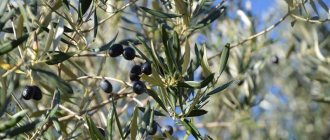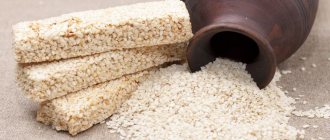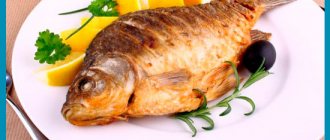The benefits of carp for the body
Eating fish has a beneficial effect on human health. Carp is one of the most common types of fish available to everyone.
Beneficial properties for the body:
- helps to recover after a long illness or physical activity;
- promotes hair growth and strengthening;
- inhibits cell aging processes;
- prevents blood pathologies;
- is a good preventative against cancer;
- normalizes sugar levels;
- saves from anemia;
- strengthens the heart muscles;
- removes waste and toxins;
- increases immunity;
- improves the condition of depression and stress;
- strengthens bones;
- normalizes the digestive system;
- prevents thyroid pathologies;
- prevention of atherosclerosis;
- stimulates brain activity;
- improves memory.
The positive effect is due to the chemical composition of this fish.
Useful properties of carp
- Carp meat contains up to 16% quickly digestible proteins with a perfectly balanced composition of amino acids. Thanks to this, it can be included in the diet menu as a source of protein.
- Carp is a natural source of cobalamin, iron and other beneficial nutrients that normalize the functioning of the hematopoietic system. With regular consumption of dishes prepared on its basis, the risk of developing anemia and other dangerous blood diseases is reduced.
- Magnesium, potassium and other nutrients contained in carp fillets strengthen blood vessels and heart muscle, thereby preventing the development of cardiac failures.
- Regular consumption of this fish helps to accelerate the removal of poisons, toxins and excess bad cholesterol from the body.
- Iodine, which enters the digestive tract along with carp meat, stimulates the production of thyroid hormones and prevents the development of thyroid diseases. This useful macronutrient promotes the mental development of children and helps the body recover faster from increased intellectual stress.
- Calcium, phosphorus and other useful macroelements, which carp is rich in, strengthen bone tissue, accelerate their healing after fractures and other injuries, and help prevent the development of osteochondrosis.
- B vitamins, present in sufficient quantities in carp fillets, also benefit the body. Compounds belonging to this class accelerate metabolic processes and normalize the functioning of the nervous system.
- The antioxidants contained in carp help the body protect cells from the damaging effects of free radicals. Regular consumption of this fish fillet can reduce the likelihood of developing cancer and slow down the aging process.
- The nutrients entering the body when eating carp help normalize the functioning of the gastrointestinal tract and activate the synthesis of digestive enzymes.
- Regular consumption of this fish helps normalize blood sugar levels. For people suffering from diabetes, it is advisable to include it in the diet once every two to three days.
- Carp is rich in substances that strengthen the immune system and help the body recover from debilitating illnesses, prolonged exposure to stressful situations, and serious physical exertion. Regular consumption of this fish reduces the risk of developing colds and increases the body's resistance to bacterial and viral infections.
- Vitamin E and other beneficial nutrients that carp fillets are rich in have a positive effect on the condition of the skin, hair, nail plates and mucous membranes.
Composition of fresh carp
Carp contains a large number of vital elements. It is valued for the fact that it contains easily digestible protein.
Nutritional value of carp, per 100 g:
| Name | quantity |
| squirrels | 15.879 g |
| fats | 5.284 g |
| carbohydrates |
Content of vitamins in carp, per 100 g:
| vitamin | quantity |
| A | 19.8 mcg |
| IN 1 | 0.137 mg |
| AT 2 | 0.053 mg |
| AT 4 | 64.836 mg |
| AT 5 | 0.186 mg |
| AT 6 | 0.168 mg |
| AT 9 | 9.288 mcg |
| AT 12 | 1.447 mcg |
| WITH | 1.489 mg |
| D | 24.687 mcg |
| E | 0.491 mg |
| TO | 0.097 mcg |
| RR | 5.492 mg |
Content of macroelements in carp, per 100 g:
| macronutrient | quantity, mg |
| potassium | 266,1 |
| phosphorus | 209,34 |
| sulfur | 179,81 |
| sodium | 54,9 |
| chlorine | 54,89 |
| calcium | 34,78 |
| magnesium | 24,77 |
Carp holds the record for the amount of phosphorus; it contains almost the same amount of this element as sturgeon.
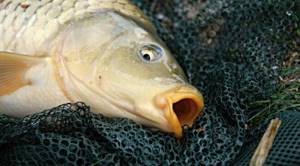
Content of microelements in carp, per 100 g:
| trace element | quantity |
| zinc | 2.07 mg |
| iron | 0.78 mg |
| manganese | 0.15 mg |
| copper | 129.84 mcg |
| chromium | 54.67 mcg |
| cobalt | 34.91 mcg |
| fluorine | 24.88 mcg |
| selenium | 12.57 mcg |
| nickel | 6.87 mcg |
| iodine | 4.82 mcg |
| molybdenum | 3.98 mcg |
In addition, 100 g of carp contains the following elements:
- Omega-3 – 0.054 g;
- Omega-6 – 0.284 g.
By regularly eating dishes prepared from carp, you can saturate your body with the necessary elements.
How many calories are in oily fish?
Healthy eating has become very popular these days. And many people who are on a diet calculate how many calories are in fish or meat. And so in relation to each product that they consume, since they cannot exceed the permitted norm per day.
Important! After cooking fish, the number of calories in it may change.
Everyone knows that fish is a very healthy product; it contains a lot of useful substances. Properties of fish:
- very easy to digest;
- contains a large amount of iodine;
- rich in proteins;
- contains vitamins A, D, E, B6 and B12;
- fish improves blood clotting;
- improves metabolism.
Sea fish has much more useful substances than river fish
It is important to remember that sea fish has much more useful substances than river fish, and river fish, in turn, has a large amount of protein.
Low-calorie fish is considered a healthy food. It is great for those who are on a diet. It is rich in phosphorus, protein, iodine. And it is more useful in boiled form:
- Pollock. How many calories per 100 g of product are contained in pollock fish: 111 calories, proteins - 23 g, fats - 1.2 g, carbohydrates - 0 g. When frying, the number of calories increases to 136.8 kcal, including proteins - 14.7 g, fats - 8.7 g, carbohydrates – 0.0 g. When boiled, the fish retains only 79 kcal, proteins – 18 g, fats – 1 g, carbohydrates – 0 g. When pollock is baked, only 80 calories remain, proteins – 16.69 g, fats – 1.62 g, carbohydrates – 0.35 g.
- Crucian carp. In 100 g of fresh product there are 87 kilocalories, proteins - 17.7 g, fats - 1.8 g, carbohydrates - 0 g. How many calories are in fried fish: 3 kcal, 16.7 g. protein, 5.4 g, fat, 1.4 g carbohydrates. In boiled crucian carp there are 102 kcal, proteins - 21 g, fat - 2 g. In baked form, 104.73 kcal, proteins - 20.98 g, fat - 1.79 g, carbohydrates - 0.21 g. Well, how many calories are in dried fish: 275 kcal, proteins – 52.4 g, fat – 5.8 g, and carbohydrates – 3.3 g.
- Hake. In its raw form, this fish contains 82 kcal, proteins - 16.6 g, fats - 2.2 g, and no carbohydrates. After the process of frying the fish, the number of kilocalories increases to 105 kcal, the amount of protein in the fried product is 14.3 g, fat – 3.5 g, carbohydrates – 2.5 g. When boiled, the energy value is 95 kcal.
Fish with red meat
- Carp. In its raw form, carp contains 112 kilocalories. The main processing of this fish is frying in a large amount of oil. And therefore, in fried carp, the kilocalories reach 196.5, the amount of protein is 18.6 g, fat is 11.6 g, carbohydrates are 4.5 g. How many calories does the boiled type of this fish have? Boiled carp has 102 kcal, proteins reach 16.0 g, fats - 3.7 g, and carbohydrates - 2.0 g.
- Pike. Calorie content of pike is 84 kcal, protein in raw fish is 18.4 g, fat is 1.1 g, carbohydrates are 0 g. How many calories are in baked fish? 74 kilocalories per 100 g of baked product, protein in it is 17.61 g, fat - 1.06 g.
All of the listed types of fish contain a very large amount of useful microelements and macroelements, minerals, chemical elements and vitamins that strengthen bones and joints.
Further we will talk about fish with a lot of calories, but this does not mean that they should be completely excluded from the diet. On the contrary, they must be consumed, as they can save you from diseases and contribute to the better functioning of your body:
- Mackerel. In fresh fish, the number of calories is 191, proteins - 18 g, fats - 13.2 g. After boiling, calories increase to 211 kcal, proteins - 20 g, fats - 15 g, and there are no carbohydrates. Smoked mackerel is very popular these days, and let's see how many calories it contains. In smoked fish, the number of kilocalories is 221, proteins - 20.7 g, fats - 20.7 g, carbohydrates - 15.5 g. Eating mackerel is a prevention of cardiovascular diseases and promotes blood circulation in the capillaries.
- Pink salmon. In an uncooked state, this fish has 142 kcal, proteins - 20.5 g, fats - 6.5 g. When boiled, calories increase to 152 kcal, proteins 21 g, fats - 7 g. If you want to fry pink salmon, be prepared for the fact that such fish will have kilocalories of 281, proteins - 17.1 g, fats - 16.4 g, and carbohydrates - 15.2 g. It is very interesting that pink salmon contains unsaturated acids, which are necessary for the absorption of nutrients.
- Salmon. All people who watch their diet are interested in the question of how many calories red fish contains: 142 kcal, proteins - 19.8 g, fats - 6.3 g. Salted salmon is one of the ways to prepare this fish. It contains 269 kcal, protein - 21 g, fat - 20.5 g. Fish prepared in this way is not recommended for those who are on a diet or who have problems with the kidneys and heart. Salmon is also steamed. It contains 135.6 kcal, protein – 17 g, fat – 6 g, and carbohydrates – 2.7 g.
- Bream. It contains 105 kilocalories, proteins - 17.1 g, fats - 4.1 g. In dried fish - 221 kcal, proteins - 42 g, fats - 5.9 g. How many calories are in boiled fish - 126 kcal, proteins - 20.9 g, fats - 4.7 g. Eating fresh bream prevents stroke; the substances contained in bream help rejuvenate the skin.
Steamed fish - this type of cooking is considered one of the best, as it is easily digestible
It is very important not to forget about how much fish should be in a person’s diet.
This is another way to cook fish. But how many calories are in steamed fish? To do this, you again need to consider each type of fish separately.
For example, salmon contains 197 kcal, proteins – 19.3 g, fats – 14 g. This is an indispensable product in the treatment of certain skin diseases. This fish also helps strengthen muscle tissue. It is recommended to consume salmon prepared in this way no more than 2 times a week.
How many calories are in sea fish? It contains 79 kcal, protein – 17.53 g, fat – 1 g. This is a light and healthy product. Most often it is recommended for people who have digestive problems.
Flounder is also steamed. Its calorie content is 90 kcal, proteins – 16.1 g, fats – 2.7 g, and carbohydrates – 0.2 g. This fish is ideal for dietary nutrition. It contains low levels of fat and is very easily absorbed by the body.
Steamed hake contains 107.35 kcal, protein – 19.16 g, fat – 5.39 g.
Both boiled and steamed fish retain the most beneficial substances contained in it. This type of preparation is considered one of the best, as it is easily digestible and after the processing process does not accumulate a large amount of fat, as happens during frying.
After drying
Contains 196 kcal.
After drying
Contains 196 kcal.
Calorie content of carp
Depending on what cooking method was used, the calorie content of the dish also changes.
Carp calorie content for different cooking methods, per 100 g of product:
Read: Can pregnant women drink milk: benefits and harms
| cooking method | number of calories |
| raw | 111,7 |
| boiled | 101,48 |
| stewed | 109,68 |
| baked | 123,9 |
| marinated | 137,8 |
| canned | 141,67 |
| fried | 197,11 |
The calorie content of fish can be affected by its habitat. The further north the place where the carp was caught, the more fat and calories it contains.
Recommended video:
https://www.youtube.com/watch?v=EAABb4RHggI
Who should not eat carp, contraindications
Before using the product for the first time, it is recommended to read the list of contraindications.
You should avoid eating carp in the following cases:
- allergic reaction to fish products;
- hypertension;
- oncological diseases.
You need to remember that there are a lot of small bones in this fish. Care must be taken, otherwise you can injure the mucous membranes of the larynx and digestive organs.
The product should not be abused. It is enough for an adult to eat carp dishes 1-2 times a week. A single serving should be 230-340 g.
Contraindications to eating carp
Farmed carp are a type of fish that are rich in omega-6 fatty acids and have virtually no omega-3 acids. That it is better for hypertensive patients, heart patients and cancer patients to treat carp with caution.
PS If the bones of a carp that has not yet been heat-treated are too easily separated from the surrounding meat, then such fish is unsuitable for consumption. Therefore, do not regret the money spent and throw the spoiled product in the trash. Health is more valuable.
Well, if the carp is fresh, then try to find your outstanding culinary skills and cook something tasty...
Carp for children
Can carp dishes be included in the children's menu? How useful is this for growth and development? At what age should a child be introduced to this fish?

Beneficial features:
- source of essential vitamins and minerals;
- improves metabolism;
- strengthens bones;
- increases immunity;
- has a positive effect on brain cells.
Tips for preparation and consumption:
- possible after the child turns 2 years old;
- no more than 1-2 times a week;
- a serving is 57-70 g.
Recommended cooking methods, options for carp dishes for children:
- cutlets;
- meatballs;
- stewed;
- steamed;
- soups;
- filling for pies.
It is necessary to carefully remove all fish bones so that they do not end up in the dish.
It is useful to include carp in children's menus, following all the recommendations of nutritionists.
What kind of fish is this?
So, carp is a fish from the carp family. It came to the human table for the first time in China in 1000 BC. Here it was a favorite delicacy of the emperors. Later, carp came to Asia and Europe. Since the 13th century it has been bred in the Czech Republic.
In appearance, carp resembles crucian carp, but with a thicker and longer body and movable lips.
Carp are divided into river and pond carp, with river carp having a longer cylindrical body, and pond carp being short and thick.
An adult is up to a meter long and can weigh up to 20 kg. Carp feeds almost constantly, as they are stomachless fish. The diet consists of crustaceans, mollusks and worms. Closer to three years, carp can reproduce.

Carp for weight loss
During a weight loss diet, you need to carefully monitor the nutritional value of the food you eat. Carp has a calorie content of 111.7 kcal, so the fish belongs to the category of medium fat content and is acceptable during the diet.
Benefits of eating carp during a diet:
- source of vitamins, minerals;
- improves metabolism;
- promotes the removal of toxins;
- strengthens muscle and bone tissue;
- gives energy, strength.

Recommendations for consuming carp dishes during a diet:
- choose gentle methods of preparing fish: boiling, stewing, baking, grilling, steaming;
- use a minimum amount of vegetable oil;
- if possible, replace salt with lemon juice;
- as a side dish, use stewed, fresh vegetables, for example, cabbage, carrots, beets, zucchini, sweet peppers;
- It is useful to combine fish dishes with fresh salads, which include cucumbers, lettuce, spinach and other vegetables;
- eat cooked carp no more than once a day;
- The serving weight should be no more than 500 g.
During the diet, you should eat carp dishes, they make it possible to get the necessary vitamins. The protein found in fish is absorbed much better than in meat products.
Carp for pregnant and lactating women
Pregnant and lactating women monitor their diet and ask a lot of questions. Will it be useful to include carp dishes in your diet? Which dishes should you prefer?
Carp contains a large amount of vitamins and minerals necessary for the health of mother and child.
Positive effects of eating carp:
- normalizes thyroid function;
- source of essential vitamins;
- has a beneficial effect on the development of child’s brain cells;
- improves the condition of the nervous system;
- increases the body's resistance to viral and colds;
- normalizes metabolism;
- participates in the formation of bone tissue.
Read: Sunny flower: the benefits of sunflower seeds

Many women at different stages of pregnancy experience problems with the digestive system, so you should not eat fried fish. It is healthier to choose gentle cooking methods. Nutritionists advise cooking fish soup from carp; it stimulates appetite and improves the functioning of the gastrointestinal tract, which is especially important during pregnancy and lactation.
Vitamin content
Table 1
| Vitamins | Content | Daily norm |
| C (ascorbic acid) | 1.5 mg | 2.14 % |
| A (retinol) | 20 mcg | 2 % |
| E (α-, β-, γ-tocopherols) | 0.5 mg | 5 % |
| D (lamisterol) | 24.7 mcg | 988 % |
| B1 (thiamine) | 0.14 mg | 9.33 % |
| B2 (riboflavin) | 0.06 mg | 3.06 % |
| B3 (PP) (nicotinamide) | 5.5 mg | 28.95 % |
| B4 (choline) | 65 mg | 13 % |
| B6 (pyridoxine) | 0.17 mcg | 8.5 % |
| B9 (folacin) | 9.3 mcg | 4.65 % |
| B12 (cobalamin) | 1.5 mcg | 50 % |
Carp contains vitamins with high, medium and low levels, if we consider them according to the approved standards for the significance of the nutritional value of the product.
At the highest level of importance in the food value chain are:
- D, takes part in the formation of bone and dental tissue.
- PP, participates in the formation of hemoglobin.
- B4, is involved in the biosynthesis of heme and proteins, cell proliferation, and tissue respiration.
- B12 is involved in many metabolic processes in the body.
Vitamins at a medium level of importance include:
- B1, required to normalize the nervous and muscular systems.
- B6, participates in the metabolism of lipids and amino acids.
Vitamins of low content include:
- C, takes part in the redox processes of the body, raises the tone of the body, strengthens the immune system.
- A, takes part in all functions of the body related to its growth and proper metabolism, preserves the structure of the cornea of the eye.
- E, keeps the muscular system in good shape.
- B2, maintains body tone.
- B9, supports the hematopoietic and digestive system.
Harm to carp
Carp is sometimes called “trash fish”. Can this fish be harmful to human health, what is the reason for this?
Carp is an omnivorous fish that lives in muddy ponds. In this regard, it can accumulate harmful substances in its meat. Therefore, it is important to pay attention to the place where the fish was caught. In environmentally unfavorable regions, carp may contain harmful substances.
Carp can be infected with parasites that are dangerous to humans; therefore, when cooking, the fish must be thoroughly heat treated.
This type of fish is most often bred in artificial reservoirs, where feed is used as food. Some manufacturers introduce antibiotics and growth hormones into the carp diet, which have a negative impact on human health.
The benefits and harms of carp caviar
Carp caviar is red, quite dense, and small. The calorie content of the product is 200 kcal per 100 g of product. Caviar contains a large amount of essential vitamins and minerals.
Useful properties of carp caviar:
- source of vital elements;
- prevention of thyroid pathologies;
- normalizes the activity of the cardiovascular system;
- increases immunity;
- gives strength and energy;
- saves from genitourinary diseases.
Caviar may contain harmful substances if the fish is caught in environmentally unfavorable regions. It must be remembered that if you have an allergic reaction to fish, seafood, eating carp caviar is unacceptable.
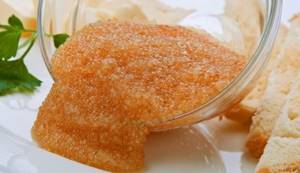
You can prepare a variety of dishes from this product: sandwiches, salads.
Carp eggs are less common than other species. It is recommended to consume this healthy and tasty product more often.
How to choose carp
The benefits of fish depend on the quality of the product. Therefore, it is important to be able to choose it correctly.
Retail outlets offer carp in the following form:
- alive;
- cooled;
- frozen.
An unpleasant odor is always considered a sign of low-quality fish. In this case, no amount of culinary processing will make such a carp a healthy and tasty dish.
Signs of a quality product:
- eyes are clean, bright;
- there is no large layer of mucus;
- gills without mucus, red or pink;
- there should be no damage on the carcass;
- If you press on the surface of the fish, it quickly restores its shape.
Carp prefer muddy bottoms, so a slight algae odor may be present.
Recommended video:
You should not buy frozen fish, the packaging of which shows pink ice crystals or snow. These signs indicate that the product was refrozen after thawing. If possible, it is better to purchase live carp caught in a store aquarium.
Application
Boiled carp is suitable both for dietary nutrition and for consumption in the everyday diet. By the way, after cooking, carp meat does not lose water, which gives it juiciness and good taste. Also, after eating there is no thirst or heaviness in the stomach. Boiled carp is not only healthy, but also tasty. This dish is excellent in combination with potatoes and many vegetables.
In addition to cooking, carp meat helps treat anemia, thyroid diseases, sclerosis, obesity, rheumatism, diabetes, and hypertension. This product must be included in the diet of people with heart and nervous system problems.
Market Analytics
- 2020 in the beauty industry – innovation without borders
- Black Lives Matter movement: reaction and consequences for the beauty industry
- COVID-19 is changing the rules of the game in the cosmetics market
Convenient search for beauty salons on our website
Beauty salons in Moscow Beauty salons in St. Petersburg Beauty salons in Ekaterinburg Beauty salons in Novosibirsk
Latest blog posts on our website
- Naturecream / Tremella Extract - Snow Mushroom Detox for Skin
- Prostye-sovety / How to visually enlarge your lips with makeup
- Naturecream / Apricot kernel oil for face
- Naturecream / MATRIXYL3000 - the best skin elasticity stimulator
- Naturecream / SPF in Natural Oils
- Naturecream / Geranium (Pelargonium) oil for skin health and beauty
- Prostye-sovety / Save on a beauty salon: procedures that can be done at home
- Naturecream / Growth Factor - brings back youth?
- Oksana-Lezina / 3 effective abdominal exercises from a fitness instructor for beginners
- Prostye-sovety / Making perfect curls at home
Latest forum topics on our website
- Natalya / How to properly make a gelatin mask?
- Mrs._Smith / Badly sunburned! What to do?((
- Ice / Is it necessary to combine fitness classes with a diet?
- Antonova / What can be used for hair loss?
- Radio operatorKat / Who was on a protein diet?
Other articles in this section
| Poached catfish Being a freshwater fish, catfish lives in reservoirs with running water. It can often be found in rivers, especially in places where there are deep holes. The catfish reaches up to five meters in length. There are individuals that weigh up to half a ton. The permanent habitat of this fish is the central part of Europe. Catfish are also found in the central regions of America and the southern territories of Canada. This species belongs to the catfish family. It has no scales and is dark yellow or completely black. |
| Sea urchin caviar Sea urchins are very interesting animals belonging to the class of echinoderms. Most species have a round body shape. Their shell is studded with a huge number of spines, which not only help the hedgehog move, but also perform a protective function. Sea urchins live mainly in the waters of the Pacific Ocean. |
| Salted herring Salted herring is a product that is a frequent guest on any table. It can be used not only on holidays (nowadays not a single feast would be complete without salted herring), but also on ordinary everyday life. It serves as an appetizer or as an ingredient in a variety of salads and dishes. In the modern world there is no need to cut herring. After all, ready-made fish fillets can be found in any store, presented in the form of preserves and canned food. |
| Breakout pollock caviar Pollock caviar is a healthy product that is affordable for everyone. The marking “shatter” on a package of caviar means that the caviar is separated from the films and cleaned of impurities. Pollock caviar looks less presentable in appearance: an inexpressive yellow-white color, a rather pungent smell, a pronounced salty taste. However, its richness in useful elements puts it on the same level as more expensive varieties of red caviar. As evidence, it can be noted that it contains vitamins of various groups - B, PP, unsaturated omega-3 polyacids. That is why this type of caviar deservedly enjoys reasonable popularity among consumers. |
| Canned fish Canned fish are processed fish products, hermetically sealed, subject to heat treatment at a fixed temperature. This thermal regime provides protection against microbes that can cause product spoilage. This is a product that does not deteriorate over time. In this case, the nutritional value deteriorates, but in some cases the taste improves. |
| White Sea navaga One of the subspecies of the Far Eastern navaga is the White Sea navaga. As a rule, its main habitat is the White Sea, but it can also be found in the waters of other northern or eastern seas. This species has an elongated shape and a fairly large size. A distinctive feature of the White Sea navaga from its relatives is the larger number of vertebrae. The best time to catch White Sea navaga is late autumn or winter. Fish caught during this period has the brightest and most persistent taste. |
| Smoked roach Roach is a commercial fish, weighing no more than 700-800 grams, about 25-30 cm long or more. The roach looks inconspicuous - the color of the belly and sides is silvery-dark, turning into black on the back. In the light it casts blue or green. |
| Sardine in oil Sardine is a small fish from the herring family, no more than 20 cm in length, living in the waters of the Atlantic Ocean and the Mediterranean. Its large scales have a beautiful appearance, shimmering in shades of blue-green in the sun. |
| Atlantic anchovy Anchovy is a small sea fish up to 20 cm long, belongs to the herring order. The weight of the fish reaches 190 grams. The habitat of the anchovy is the waters of tropical and temperate tropical latitudes. |
| Braised catfish Catfish is one of the largest freshwater fish and belongs to the catfish family. This species has no scales. Catfish can reach up to five meters in length and weigh half a ton. The color of the fish can be dark yellow or black. It lives in the central part of Europe, as well as in the waters of the American coast. The fish lives in large bodies of water with running water or rivers. At the same time, deep holes where it spends the winter are an essential factor in the habitat of catfish. |
The best carp recipes
Carp has been cooked tasty and healthy for a long time in different countries. In China, it is fried, boiled, baked, and made in sweet and sour sauce. In Bulgaria, you can find carp stuffed with nuts. In France they like to serve it with mushroom filling. In Hungary, smoked lard and paprika are used when preparing carp. In Germany and Poland, you can find carp stewed in beer in restaurants. There are a large number of recipes for preparing this fish in world cuisine.
Read: How to reduce blood glucose, what foods can be consumed for diabetes
Carp has a slight specific smell, so it is important to choose the right spices.
The following spices and seasonings are best:
- Bay leaf;
- garlic;
- ginger;
- basil;
- thyme.
When purchasing fish for cooking, it is important to remember that only a high-quality product will make a tasty dish.
Carp baked in the oven
Ingredients:
- medium-sized carp – 1 pc.;
- lemon – 1 pc.;
- parsley – 1 bunch;
- salt, pepper - to taste.
Cooking technology:
- Clean, remove entrails, and wash the fish. Do not cut off the head or tail.
- Mix salt and pepper. Rub this mixture onto the carp.
- Squeeze the juice from half a lemon, sprinkle on top and inside.
- Place the fish in a baking dish.
- Cut half a lemon into thin slices and spread over the surface of the carp.
- Cover the top with foil.
- Bake at 180 degrees for half an hour.
- Remove the foil and place in the oven for another 15-20 minutes.
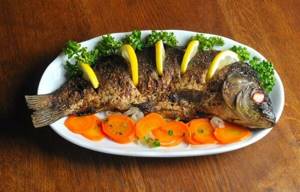
It is recommended to use boiled potatoes and stewed vegetables as a side dish.
You can easily and simply cook fish directly while fishing using a grill and coals.
Carp in foil on coals
Ingredients:
- carp – 1.2 kg;
- salt, pepper - to taste;
- lemon – 1 pc.;
- onion – 2 heads;
- cucumber – 3 pcs.
Cooking technology:
- Clean, gut and wash the fish.
- Chop vegetables and add salt.
- Mix the spices and rub the carp with them.
- Stuff the belly of the fish with vegetables.
- Place thin lemon slices on top.
- Wrap the resulting fish in foil, you can use several layers.
- Bury the carp in the coals.
- Cook for 25-30 minutes.

If the fish is larger in size, then it is necessary to increase the cooking time.
Carp in sour cream
Ingredients:
- carp – 1-1.2 kg;
- onions – 2 pcs.;
- sour cream – 200 g;
- water – 50 ml;
- salt, pepper - to taste;
- flour – 2 tablespoons;
- vegetable oil.
Cooking technology:
- Cut the prepared clean fish into pieces, add salt and pepper.
- Fry, first roll in flour.
- Cut the onion into rings and fry a little.
- Place the fish in the pan and place the onion on top.
- Dilute sour cream with water and pour over carp. Cook over low heat for 5-7 minutes after baking.
- Remove from the stove, close the lid, and let stand for 10 minutes.
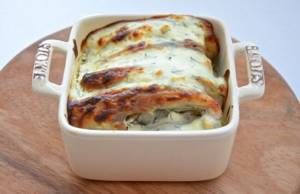
Serve the dish hot.
Carp is a healthy, affordable, tasty fish. You can eat dishes made from carp at any age. It is recommended to include in the diet of pregnant women and young children.
Fish can be not only useful, but you must remember about contraindications. In addition, you need to choose the right quality product and pay attention to the place where the carp was caught.
In world cuisine, there are many different dishes that include carp. Regular consumption of this fish saturates the body with vital elements.
Recommended video:
https://www.youtube.com/watch?v=4w4iNBEhGd8
Read along with this article:
- Mackerel - proteins, fats, carbohydrates, beneficial and harmful properties of fish
- Beneficial properties of capelin and its calorie content
- What are the benefits of spinach for women, how to use its properties
- Chemical composition of peanuts, beneficial properties for adults and children
- Do sunflower and pumpkin seeds make you better?
- How to cook couscous so that it is healthy
- Coconut milk calorie content, composition, properties
- Can a nursing mother eat cabbage? Will the vegetable harm the baby’s health?
- How many calories are in walnuts and what are they good for?

